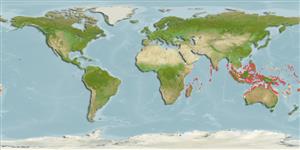>
Gobiiformes (Gobies) >
Gobiidae (Gobies) > Gobiinae
Etymology: Istigobius: Greek, istios = sail + Latin, gobius = gudgeon (Ref. 45335).
Eponymy: Charles Francis Spence (1907–1982) was a businessman in Mozambique, the type locality, whom Smith thanked for providing personal assistance. Spence later published: The Portuguese Colony of Moçambique: an Economic Survey (1951). (Ref. 128868), visit book page.
More on author: Smith.
Environment: milieu / climate zone / depth range / distribution range
Ecologie
marien; brak water rifbewoner; diepte 1 - 12 m (Ref. 90102). Tropical; 15°N - 40°S
Indo-Pacific: Mozambique, Kenya, Sri Lanka, Papua New Guinea, Australia, and Micronesia; undoubtedly more widespread.
Grootte / Gewicht / Leeftijd
Maturity: Lm ? range ? - ? cm
Max length : 7.9 cm SL mannelijk / geslacht onbekend; (Ref. 1602)
Dorsale stekels (totaal) : 7; Dorsale zachte stralen (totaal) : 10 - 11; Anale stekels: 1; Anale zachte stralen: 9 - 10; Wervels: 26. Pectoral fin rays entire. Predorsal cycloid scale 7-10, ctenoid on trunk. Few spots on nape; a dusky line running from eye dorsal to sensory pore path, ending at or before pectoral fin base; wavy brown lines on the snout. Pelvic and distal part of anal fins darker in males than in females. Appressed anal fin reaching within a distance of 1-2 scales of caudal fin in male, 2-4 scales in female; appressed 2nd dorsal slightly overlapping caudal in male. Some males exhibit 3-4 vertical bars on abdomen and 2-3 horizontal bars in 1st dorsal fin (Ref. 420); longitudinal scale series 30-32; no scales on cheek and opercle; body depth 4.9-6.1 in SL (Ref. 90102).
Occurs in turbid coastal areas near river mouths at less than 1 m to at least 12 m, Ref. 48637.
Levenscyclus en paargedrag
Maturiteit | Voortplanting | Paaien | Eieren | Fecunditeit | Larven
Genital papilla of male reaching anal spine. Female genital papilla truncate, ending well before origin of anal fin.
Murdy, E.O. and D.F. Hoese, 1985. Revision of the gobiid fish genus Istigobius. Indo-Pac. Fish. (4):41 p. (Ref. 420)
Status op de Rode Lijst van het IUCN (Ref. 130435: Version 2024-2)
Gevaar voor de mens
Harmless
Gebruik door de mens
Tools
Speciale rapporten
Download XML
Internetbronnen
Estimates based on models
Preferred temperature (Ref.
123201): 25.7 - 29.3, mean 28.6 °C (based on 2615 cells).
Fylogenetische diversiteitsindex (Ref.
82804): PD
50 = 0.5010 [Uniqueness, from 0.5 = low to 2.0 = high].
Bayesian length-weight: a=0.01023 (0.00477 - 0.02194), b=3.01 (2.83 - 3.19), in cm total length, based on LWR estimates for this (Sub)family-body shape (Ref.
93245).
Trofisch niveau (Ref.
69278): 3.3 ±0.4 se; based on size and trophs of closest relatives
Weerstandsvermogen (Ref.
120179): Hoog, minimale populatieverdubbelingstijd minder dan 15 maanden (Preliminary K or Fecundity.).
Fishing Vulnerability (Ref.
59153): Low vulnerability (10 of 100).
Nutrients (Ref.
124155): Calcium = 139 [69, 301] mg/100g; Iron = 0.849 [0.417, 1.558] mg/100g; Protein = 18.7 [16.7, 20.3] %; Omega3 = 0.153 [0.067, 0.292] g/100g; Selenium = 16.6 [8.1, 37.8] μg/100g; VitaminA = 145 [39, 485] μg/100g; Zinc = 2.53 [1.67, 3.75] mg/100g (wet weight);
